Here a collection of the best Cordyceps photos I took during our Mushroaming Bolivia's Amazon Rain Forest Tour, January 20 through February 2, 2012. Unless otherwise specified the fungi were found between 250 to 400m a.s.l. All specimens have been deposited in the National Herbarium in La Paz, Bolivia. Note all these fruiting bodies are growing post-mortem out of the parasitized insects.
Link to the 2014 Mushroaming Cordyceps Expedition to Tibet
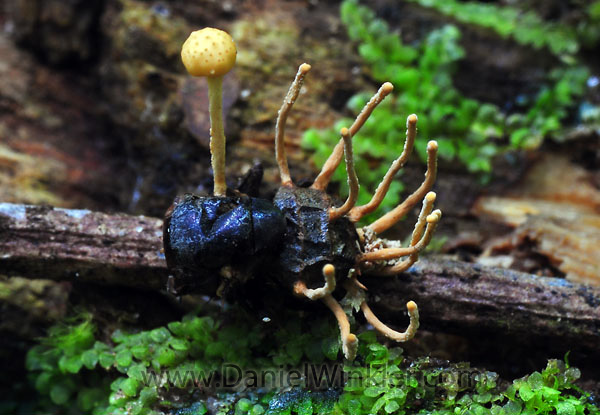
Link to the 2014 Mushroaming Cordyceps Expedition to Tibet

1) Ophiocordyceps dipterigena and its anamorph, the asexual reproducing Hymenostilbe dipterigena. On the left is one capitate fruiting body [the fertile tissue is clearly separated from the stem of the stroma / fruiting body], which produces the spores for Ophiocordyceps dipterigena. On the right 10 conidophores of Hymenostilbe dipterigena, that are producing conidia, asexually generated reproductive cells [think self-cloning]. The pimpled upper part of the stalks looks like it is already producing conidia. This Cordyceps attacks flies in tropical forests in Asia, Africa and America. This was the first Cordyceps I found and it was tiny, the whole thing not bigger than 1 cm. Also the carcass of the fly was not complete, which was fixed by the Cordyceps to a tiny stick or leaf stem. I was helped by the identification by Tatiana Sanjuan, who is working on her PhD on Amazon Cordyceps species.
Location: Cerro Brujo,Rurrenabaque, Bolivia
[More background on this species on the Corvallis Cordyceps page. Also there is a range of biomedical research published on this species, it contains exobiopolymers, which are important agents in industrial as well as health application, i.e. for wound healing.]
[More background on this species on the Corvallis Cordyceps page. Also there is a range of biomedical research published on this species, it contains exobiopolymers, which are important agents in industrial as well as health application, i.e. for wound healing.]
Cordyceps acridophila
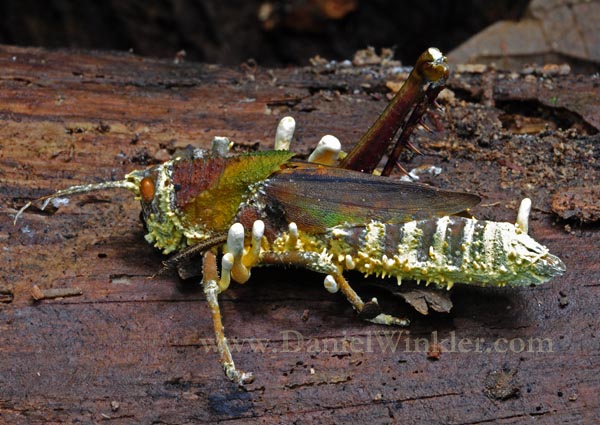
2) A colorful grasshopper in some areas over-grown by a Cordyceps that is also growing half a dozen fruiting bodies. The fungus is Cordyceps acridophila on Agriacris plagiata (Orthoptera: Romaleidae). Talking about a deadly embrace! Found by Nicole Cook near Caquihuara Macaw Cliff, Madidi National Park, Bolivia.
Akanthomyces sp.
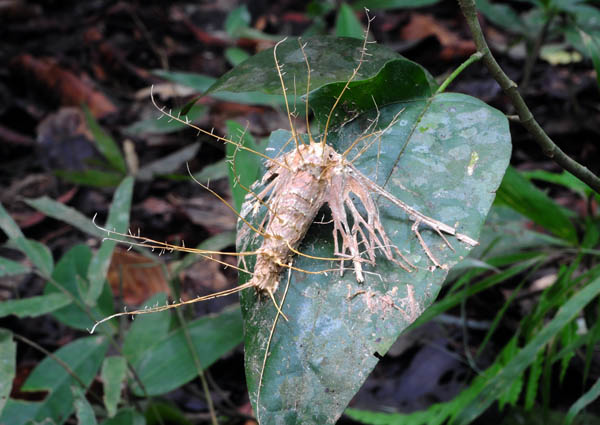
3) On of my favorite specimens was this oldish 8 cm sphinxoid moth digested by a Cordyceps. It is an Akanthomyces species (Tatiana suggests A. pistilariformis), an anamorphic fungus related to Cordyceps. Anamorphic means this fungus does not reproduce sexually with spores, but produces conidia, which have the same DNA as the fungus. It already has shed all its conidia, which grow on the antenna-like structures, called conidiophores. Check out Isaria tenuipes below, that gives you an idea how many conidia can be grown by an anamorph. The fungus affixed the moth to the leaf so it can keep this great perch to disperse its "spores" successfully. Madidi National Park, Bolivia.
Isaria tenuipes
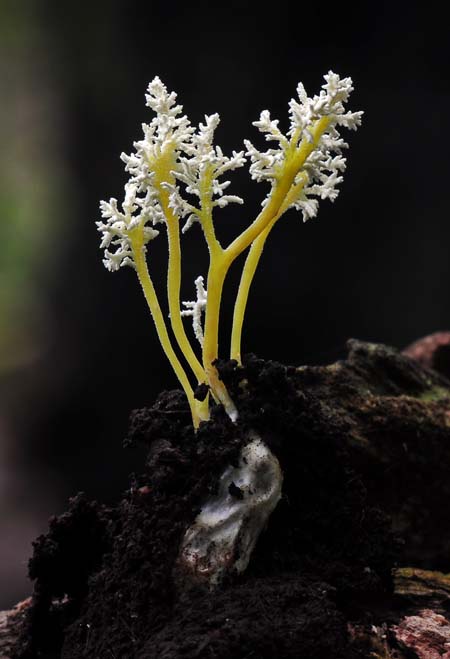
4) An Isaria tenuipes Peck, another Cordyceps-anamorph growing out of a Pupa of Noctunidae found in the hollow of a very decayed tree trunk.
Fruiting body height 5cm. Chalalan, Madidi National Park, Bolivia.

5) Another Isaria tenuipes with tons of conidia or conidiospores. The attic greek root of the term conidia means dust. Isaria is a cosmopolitan species. I am not sure if the infected insect was very hairy or some other organism is responsible for all the brittles. Chalalan, MadidiNational Park, Bolivia.
Ophiocordyceps australis

6) A red fruiting Ophiocordyceps australis fruiting from an ant between Xylaria fruiting bodies. At first I was just trying to get a picture of the Xylaria then I saw the Cordyceps. Key for finding Cordyceps is slowing down and looking carefully. Best substrate are decaying tree trunks, but many other locations are sites Cordyceps will direct its prey to before killing it and digesting it. Chalalan, Madidi National Park, Bolivia.

7) A transect of the head of an Ophiocordyceps australis reveals seed-like structures, which are the perithecia containing the asci-sacs in which the spores are produced. Size of the head is about 8 mm. Chalalan, Madidi National Park, Bolivia.
Ophiocordyceps australis
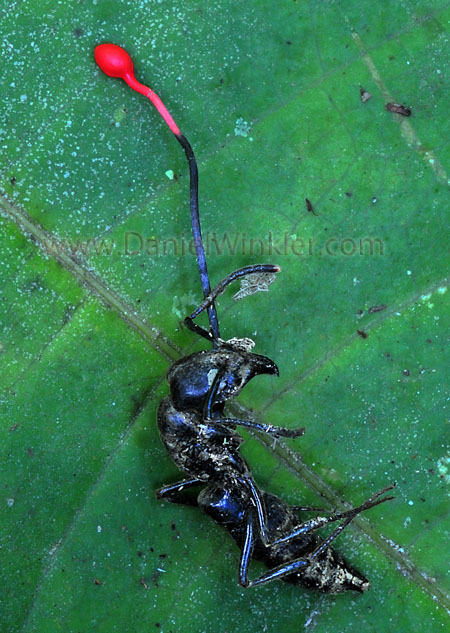
8) Ophiocordyceps australis growing out of an ant.
Cerro Brujo, Rurrenabaque, Bolivia
Metacordyceps martialis? and Ophiocordyceps australis
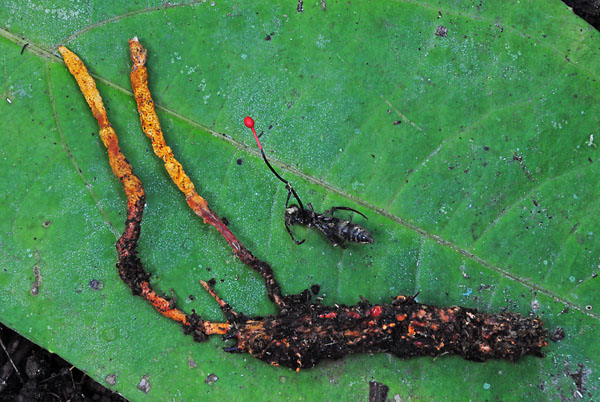
9) A late stage Metacordyceps, probably Metacordyceps martialis laying next to Ophiocordyceps australis.
Found by Brendan O'Brian at Cerro Brujo, Rurrenabaque, Bolivia
Metacordyceps sp.?
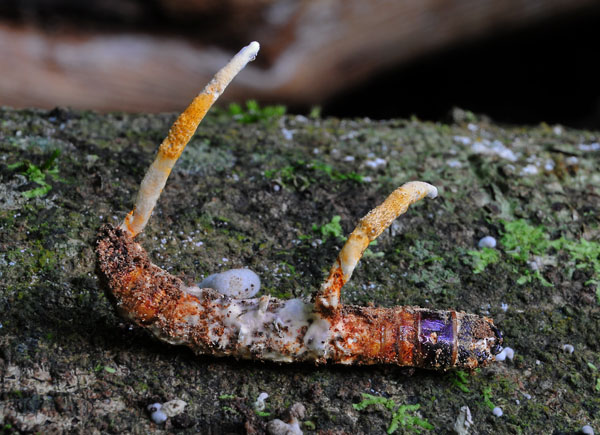
10) A much fresher specimen, probably a Metacordyceps. The fruiting bodies are growing out of a coleopteran larva (length ca 6 cm).
Cerro Brujo, Rurrenabaque, Bolivia
The enlarged fruiting body
 10a) The yellow area in the center of the stromata contains mature perithecia. The darkish spots are the ostioles, the opening of the perithecium through which the spores are released. The top white part is not fully differentiated yet and still growing. When maturing it will turn yellow too and develop the pimpled surface due to growth of the perithecia.
10a) The yellow area in the center of the stromata contains mature perithecia. The darkish spots are the ostioles, the opening of the perithecium through which the spores are released. The top white part is not fully differentiated yet and still growing. When maturing it will turn yellow too and develop the pimpled surface due to growth of the perithecia.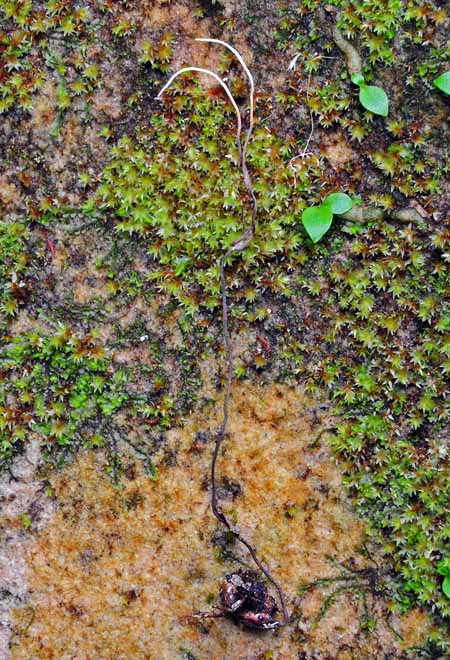
11) Probably a Hirsutella, a Cordyceps anamorph. As typical for an anamorph this specimen is lacking a well-defined "head". Hirsutella-species will depend on the digested insect. Found by Colden McClurg at Cerro Brujo, Rurrenabaque, Bolivia. Identified by Tatiana Sanjuan.

12) Ophiocordyceps kniphofiodes var. ponerinae jutting out of a dead trunk. Ponerinae refers to the group of ants this Ophiocordyceps attacks. I love the orange-black contrast. The orange is the fertile tissue. Identified by Tatiana Sanjuan. Chalalan, Madidi National Park, Bolivia.

12a) Here the same Ophiocordyceps kniphofiodes var. ponerinae with its victim or host, whichever perspective one takes, a Ponerinae ant dug out of the rotten wood. Unfortunately my camera was fogged-up that morning. Photographing in the rain forest, even when it does not rain is a real challenge. My flash stopped working for 5 days, but once out of the humidity it came back to life, go figure! Chalalan, Madidi National Park, Bolivia.
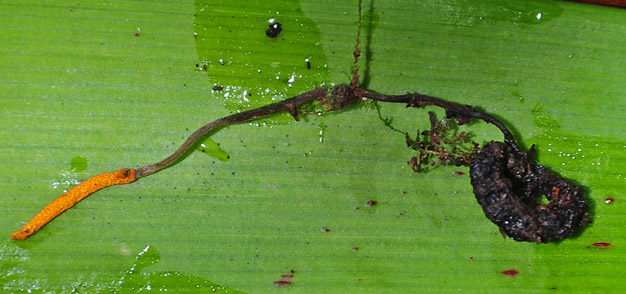
13) A similar looking Cordyceps we encountered in Coroico in the Yungas, the cloud forest belt in around 1500 m asl. Found by Nicole Cook.
If the host is a Megaloptera larvae, which it seems to be, then this would be the newly described Ophiocordyceps tiputini, according to Tatiana Sanjuan.
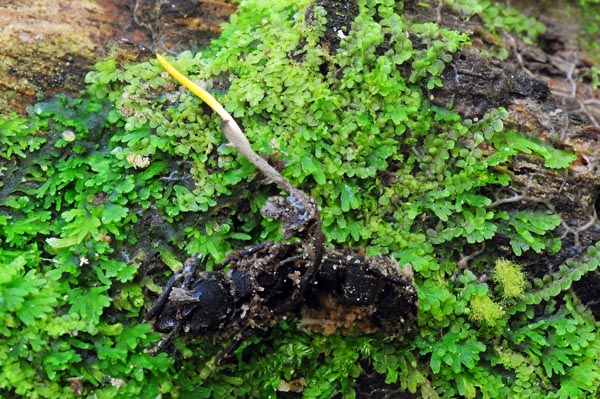
14) Another ant-parasitizing Ophiocordyceps kniphofioides var. ponerinae. This stroma is not fully matured yet.
Found by Brendan O'Brien at Cerro Brujo, Rurrenabaque, Bolivia.
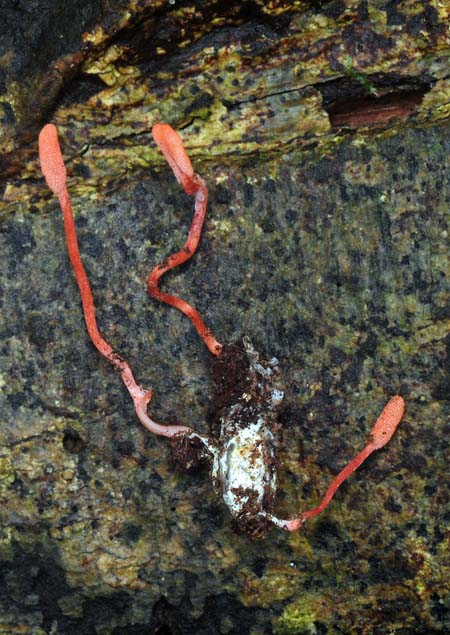
15) A brightly red fruiting Cordyceps growing out of some insect protein. Trying to figure out what it could be, I came up with Cordyceps pruinosa due to color and perithecia shape and alignment. However, so far this species is not described from the neotropics, but known from East Asia. Tatiana Sanjuan informed me that she found many specimen of C. pruinosa in the Amazon and depending on the host it could be C. caloceroides (parasitizing on Theraphosidae / tarantula) or C. pruinosa (parasitizing eggs of Acrididae / grasshoppers). Furthermore she sugests that with application of KOH these fungi turn purple. Found by Pat Hill in Chalalan, Madidi National Park, Bolivia.
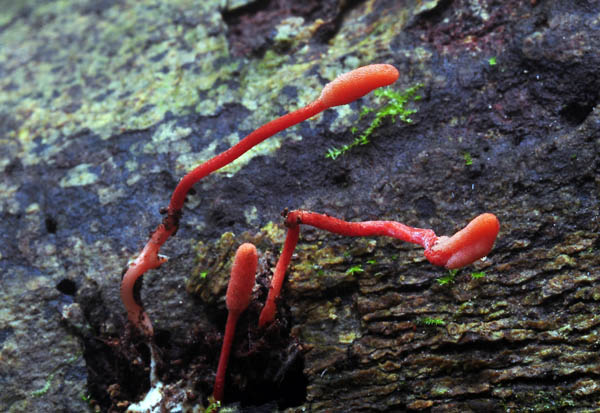
15a) Partly extracted from the log, the kink in one of the stromata was caused when it hit the tough bark and changed direction to find its way out.
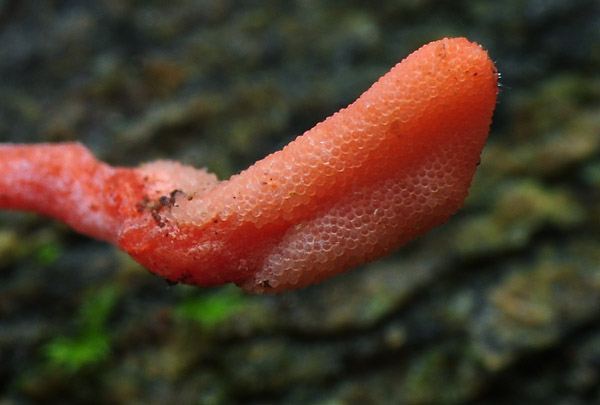
15b) What color, what beautiful structure! Chalalan, Madidi National Park, Bolivia.
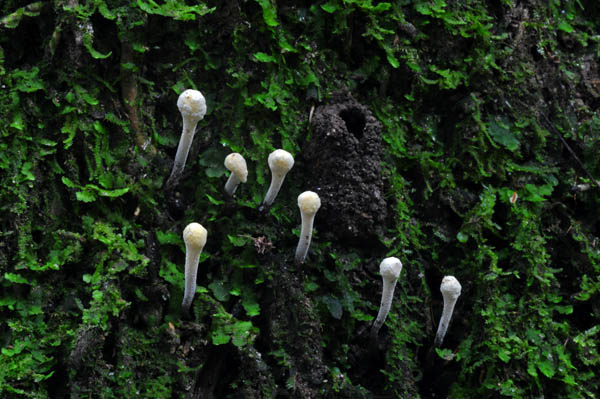
16) Fruiting bodies growing out of a mesh of palm roots. I waited for three days to unearth the host insect in hope the fungus would further mature. Unfortunately digging down to the host insect was impossible. It was all totally intertwined palm roots looking absolutely identical to the black lower part of the stromata and before I got to any insect I had already broken off or sliced off the fungal tissue from its elusive base. Last straw was when I cut my finger. Should have brought a big saw! Chalalan, Madidi National Park, Bolivia.
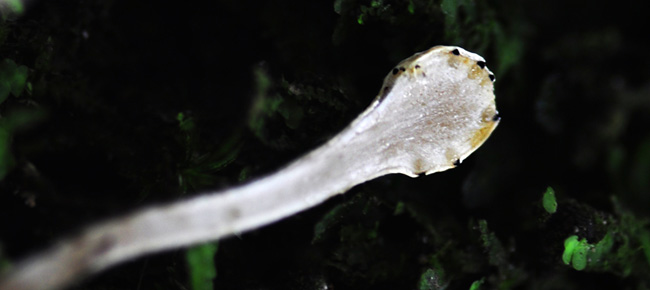
16a) Transect of the Cordyceps shown above. The perithecia are not fully developed yet. Larry Evans tried to find spores under the microscope, but to no avail.
Torrubiella sp.
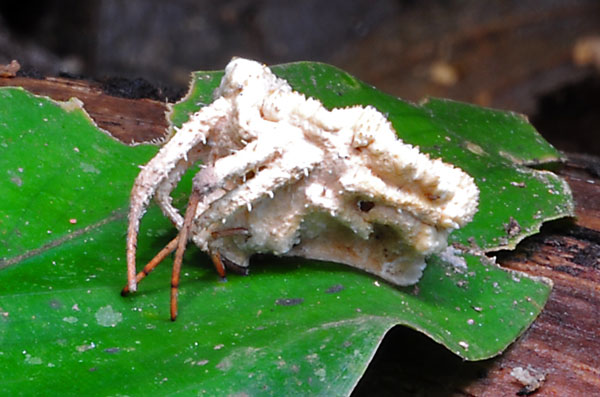
17) A Salticidae spider fully enmeshed in fungal tissue by a Torrubiella species. Size is about 3 cm across. Found by Colden McClurg near Caquihuara Macaw Cliff, Madidi National Park, Bolivia.
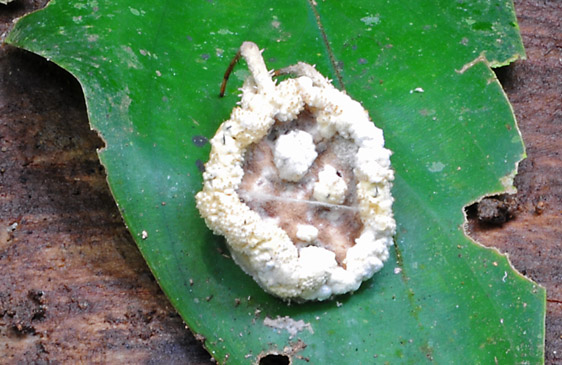
17a) Looking at the top of the former spider. The ring-like structure and the round knobs inside the ring are packed with perithecia<radeditorformatted_1> of the Torrubiella fungus.
Link to the 2014 Mushroaming Cordyceps Expedition to East Tibet
